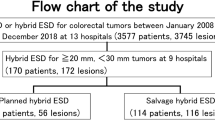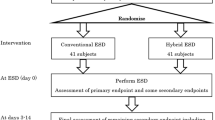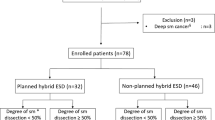Abstract
Background and Aims
Hybrid endoscopic submucosal dissection (H-ESD), a modified ESD with a snare, has become increasingly utilized to overcome the limitations of conventional ESD (C-ESD). This study aimed to compare the efficacy and safety of Planned H-ESD and C-ESD for colorectal lesions.
Methods
Propensity score matching was performed to control for confounding variables in this retrospective study. Outcomes included en bloc resection and complete resection (R0) rates, procedure time, adverse event rates, and local recurrence rate.
Results
1286 lesions were enrolled in the study. After matching, 263 lesions were assigned to each group. The Planned H-ESD group has lower en bloc rate but similar R0 resection rate compared to the C-ESD group (90.9% vs 98.1%, P = 0.001; 77.2% vs 77.9%, P = 0.917). The median procedure time was shorter in the Planned H-ESD group (27.0 min vs 35.0 min, P = 0.001). There were no significant differences in adverse events rates or local recurrence rate. Subgroup analysis based on lesion size revealed that a significantly lower en bloc resection rate in the Planned H-ESD group compared to the C-ESD group for lesions ≥ 40 mm (71.0% vs 94.3%, P = 0.027), but there was no significant difference for lesions < 40 mm.
Conclusion
The Planned H-ESD has a lower en bloc resection rate but a similar R0 resection rate, adverse event rates, local recurrence rate, and shorter procedure duration. Compared to C-ESD, Planned H-ESD presents advantages for managing colorectal neoplasms below 40 mm.
Graphical Abstract




Similar content being viewed by others
References
Sung H, Ferlay J, Siegel RL et al. Global Cancer Statistics 2020: GLOBOCAN estimates of incidence and mortality worldwide for 36 cancers in 185 countries. CA Cancer J Clin 2021;71:209–249.
Kuipers EJ, Grady WM, Lieberman D et al. Colorectal cancer. Nat Rev Dis Primers 2015;1:15065.
De Ceglie A, Hassan C, Mangiavillano B et al. Endoscopic mucosal resection and endoscopic submucosal dissection for colorectal lesions: a systematic review. Crit Rev Oncol Hematol 2016;104:138–155.
Moss A, Williams SJ, Hourigan LF et al. Long-term adenoma recurrence following wide-field endoscopic mucosal resection (WF-EMR) for advanced colonic mucosal neoplasia is infrequent: results and risk factors in 1000 cases from the Australian Colonic EMR (ACE) study. Gut 2015;64:57–65.
Draganov PV, Wang AY, Othman MO et al. AGA Institute Clinical Practice Update: endoscopic submucosal dissection in the United States. Clin Gastroenterol Hepatol 2019;17:16-25.e1.
Tanaka S, Kashida H, Saito Y et al. Japan Gastroenterological Endoscopy Society guidelines for colorectal endoscopic submucosal dissection/endoscopic mucosal resection. Dig Endosc 2020;32:219–239.
Libânio D, Pimentel-Nunes P, Bastiaansen B et al. Endoscopic submucosal dissection techniques and technology: European Society of Gastrointestinal Endoscopy (ESGE) technical review. Endoscopy 2023;55:361–389.
Ohata K, Kobayashi N, Sakai E et al. Long-term outcomes after endoscopic submucosal dissection for large colorectal epithelial neoplasms: a prospective, multicenter, cohort trial from Japan. Gastroenterology 2022;163:1423-1434.e2.
Imai K, Hotta K, Ito S et al. A risk-prediction model for en bloc resection failure or perforation during endoscopic submucosal dissection of colorectal neoplasms. Dig Endosc 2020;32:932–939.
Lim XC, Nistala KRY, Ng CH et al. Endoscopic submucosal dissection vs endoscopic mucosal resection for colorectal polyps: a meta-analysis and meta-regression with single arm analysis. World J Gastroenterol 2021;27:3925–3939.
Byeon J-S, Yang D-H, Kim K-J et al. Endoscopic submucosal dissection with or without snaring for colorectal neoplasms. Gastrointest Endosc 2011;74:1075–1083.
Milano RV, Viale E, Bartel MJ et al. Resection outcomes and recurrence rates of endoscopic submucosal dissection (ESD) and hybrid ESD for colorectal tumors in a single Italian center. Surg Endosc 2018;32:2328–2339.
McCarty TR, Bazarbashi AN, Thompson CC et al. Hybrid endoscopic submucosal dissection (ESD) compared with conventional ESD for colorectal lesions: a systematic review and meta-analysis. Endoscopy 2021;53:1048–1058.
Toyonaga T, Man-I M, Morita Y et al. Endoscopic submucosal dissection (ESD) versus simplified/hybrid ESD. Gastrointest Endosc Clin N Am 2014;24:191–199.
Bae JH, Yang D-H, Lee S et al. Optimized hybrid endoscopic submucosal dissection for colorectal tumors: a randomized controlled trial. Gastrointestinal Endoscopy 2016;83:584–592.
Fuccio L, Hassan C, Ponchon T et al. Clinical outcomes after endoscopic submucosal dissection for colorectal neoplasia: a systematic review and meta-analysis. Gastrointest Endosc 2017;86:74-86.e17.
Okamoto Y, Oka S, Tanaka S et al. Indications and outcomes of colorectal hybrid endoscopic submucosal dissection: a large multicenter 10-year study. Surg Endosc 2022;36:1894–1902.
Okamoto K, Muguruma N, Kagemoto K et al. Efficacy of hybrid endoscopic submucosal dissection (ESD) as a rescue treatment in difficult colorectal ESD cases. Dig Endosc 2017;29:45–52.
Schlemper RJ, Riddell RH, Kato Y et al. The Vienna classification of gastrointestinal epithelial neoplasia. Gut 2000;47:251–255.
Kudo S, Kashida H, Yamano H et al. Laterally spreading tumors of the colon. Gastrointestinal Endoscopy 1996;43:367.
Endoscopic Classification Review Group. Update on the paris classification of superficial neoplastic lesions in the digestive tract. Endoscopy 2005;37:570–578.
Matsumoto A, Tanaka S, Oba S et al. Outcome of endoscopic submucosal dissection for colorectal tumors accompanied by fibrosis. Scand J Gastroenterol 2010;45:1329–1337.
Cecinato P, Lucarini M, Azzolini F et al. Endoscopic submucosal tunnel dissection vs conventional endoscopic submucosal dissection for large colorectal neoplasms: a single-centre retrospective study. Tech Coloproctol 2023;27:317–323.
Seo M, Song EM, Cho JW et al. A risk-scoring model for the prediction of delayed bleeding after colorectal endoscopic submucosal dissection. Gastrointest Endosc 2019;89:990–998.
Paspatis GA, Dumonceau J-M, Barthet M et al. Diagnosis and management of iatrogenic endoscopic perforations: European Society of Gastrointestinal Endoscopy (ESGE) Position Statement. Endoscopy 2014;46:693–711.
Qiu J, Ouyang Q, Zhang Y et al. Post-endoscopic submucosal dissection electrocoagulation syndrome: a clinical overview. Expert Rev Gastroenterol Hepatol 2022;16:1079–1087.
Kuroki Y, Hoteya S, Mitani T et al. Endoscopic submucosal dissection for residual/locally recurrent lesions after endoscopic therapy for colorectal tumors. J Gastroenterol Hepatol 2010;25:1747–1753.
Chow CWS, Fung TLD, Chan PT et al. Endoscopic submucosal dissection for colorectal polyps: outcome determining factors. Surg Endosc 2023;37:1293–1302.
Kamigaichi Y, Oka S, Tanaka S et al. Factors for conversion risk of colorectal endoscopic submucosal dissection: a multicenter study. Surg Endosc 2022;36:5698–5709.
Yamaguchi H, Fukuzawa M, Kawai T et al. Significance of rescue hybrid endoscopic submucosal dissection in difficult colorectal cases. Clin Endosc. 2023. https://doi.org/10.5946/ce.2022.268.
Seo M, Yang D-H, Kim J et al. Clinical outcomes of colorectal endoscopic submucosal dissection and risk factors associated with piecemeal resection. Turk J Gastroenterol 2018;29:473–480.
Austin PC, Stuart EA. Moving towards best practice when using inverse probability of treatment weighting (IPTW) using the propensity score to estimate causal treatment effects in observational studies. Stat Med 2015;34:3661–3679.
Yoshida N, Inoue K, Hashimoto H et al. Standard endoscopic mucosal resection vs precutting endoscopic mucosal resection using novel disk-tip snare for colorectal lesions. Dig Dis Sci 2023;68:2030–2039.
Oh CK, Cho YW, Choi IH et al. Comparison of precutting endoscopic mucosal resection and endoscopic submucosal dissection for large (20–30 mm) flat colorectal lesions. J Gastroenterol Hepatol 2022;37:568–575.
Yang D, Aihara H, Perbtani YB et al. Safety and efficacy of endoscopic submucosal dissection for rectal neoplasia: a multicenter North American experience. Endosc Int Open 2019;7:E1714–E1722.
Jung Y, Kim JW, Byeon J-S et al. Factors predictive of complete excision of large colorectal neoplasia using hybrid endoscopic submucosal dissection: a KASID Multicenter Study. Dig Dis Sci 2018;63:2773–2779.
Acknowledgments
Financial support and technical assistance were not received for this study.
Author information
Authors and Affiliations
Contributions
SGD and YXZ designed the study; YXZ and XL collected and/or analyzed the data; YXZ wrote the initial draft of the manuscript; FG assisted in revision of the manuscript; SGD critically reviewed the manuscript and approved the final version of the manuscript. All authors approved the manuscript and agree on submission of the manuscript for publication.
Corresponding author
Ethics declarations
Conflict of interest
The authors declare no conflicts of interest.
Ethical approval
This study was approved by the Medical Ethics Committee of Peking University Third Hospital (M2022769).
Additional information
Publisher's Note
Springer Nature remains neutral with regard to jurisdictional claims in published maps and institutional affiliations.
Supplementary Information
Below is the link to the electronic supplementary material.
Rights and permissions
Springer Nature or its licensor (e.g. a society or other partner) holds exclusive rights to this article under a publishing agreement with the author(s) or other rightsholder(s); author self-archiving of the accepted manuscript version of this article is solely governed by the terms of such publishing agreement and applicable law.
About this article
Cite this article
Zhang, Yx., Liu, X., Gu, F. et al. Planned Hybrid Endoscopic Submucosal Dissection as Alternative for Colorectal Neoplasms: A Propensity Score-Matched Study. Dig Dis Sci 69, 949–960 (2024). https://doi.org/10.1007/s10620-023-08195-7
Received:
Accepted:
Published:
Issue Date:
DOI: https://doi.org/10.1007/s10620-023-08195-7




